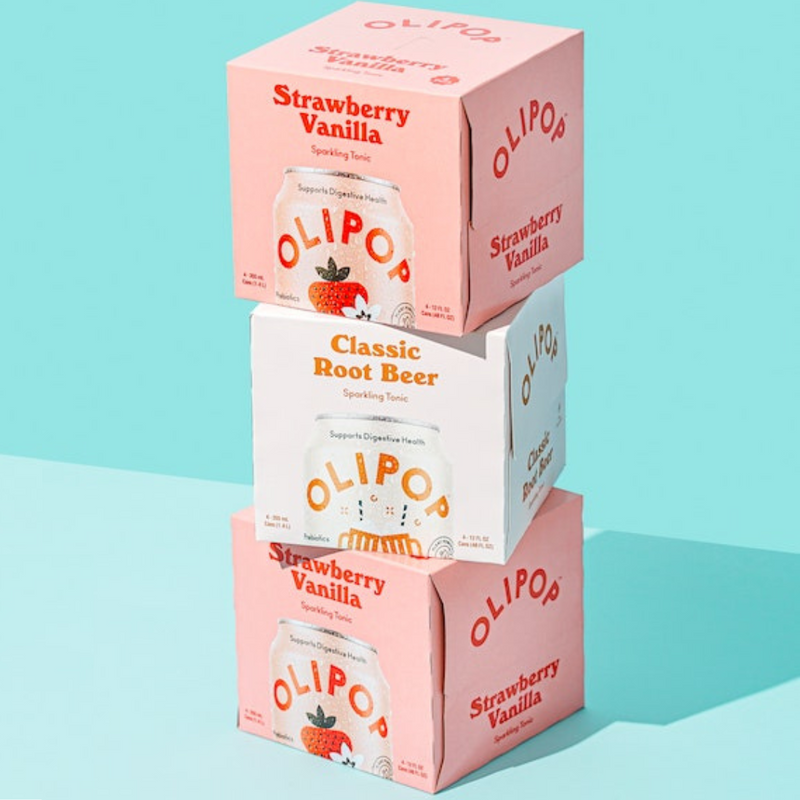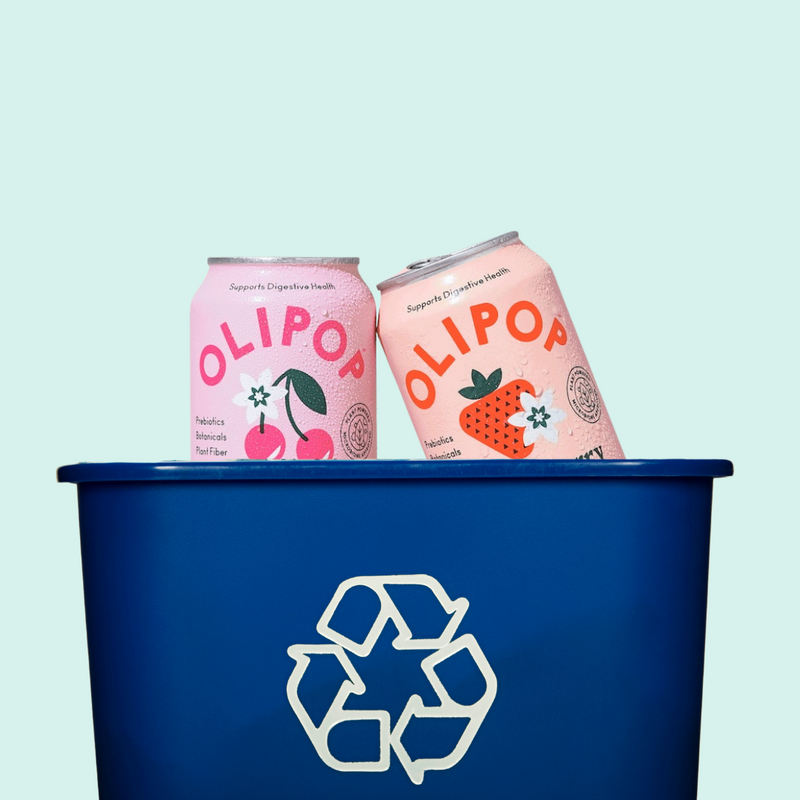When you're putting food or drink into your body, it's essential to know how that item stacks up nutrition-wise. And the best way to get that info is by reading the nutrition label. You can find this chart on the side panel or back of your cereal box or can of soda. It gives you a glimpse into exactly how nutritionally balanced that food or drink really is.
Every can of delicious OLIPOP comes with a nutrition label, allowing you to know precisely what you are getting when you crack open a can.
If you are a nutrition label-reading novice, don't fret. With a bit of know-how, you can easily navigate the words and values found on your can and make sense of it in a snap. Read on to learn how to read and understand the OLIPOP nutrition label.
OLIPOP Nutrition Facts
First things first, let's take a look at the back nutrition label of an OLIPOP can. Here are the nutrition facts for our Classic Root Beer:
- Calories: 35
- Total Fat: 0g
- Sodium: 25mg
- Total Carbohydrate: 16g
- Dietary Fiber: 9g
- Total Sugars: 2g
- Added Sugars: 2g
- Protein: 0g

Breaking Down the OLIPOP Nutrition Label
Next, we'll break down everything you're seeing on the back nutrition label of a can of OLIPOP and other food or beverage items. The nutrients you want to look out for on the nutrition label (and eat or drink less of!) are saturated and trans fats, sodium, and added sugars.
Let's take a look...
Ingredients List
The ingredients list tells you every ingredient that is in the product. Ingredients are listed in order by weight. That means the first ingredient on the list weighs the most (and the food or drink contains more of that ingredient). And the last item on the list weighs the least.
On the ingredient list of a can of OLIPOP, you will find items like carbonated water, chicory root inulin, natural juices, and stevia leaf. What you will not find on the list is high fructose corn syrup or any artificial colors or flavors.
Serving Size or Servings Per Package
You can find the serving size listed at the top of the nutrition label. Serving size is the amount of food or drink typically consumed in one serving. It uses standard household measures like a cup, a slice, grams (g), or a tablespoon.
Serving size is not necessarily a recommendation of how much you should eat or drink of a product. It's there to establish a standard measurement on which to base the rest of the nutrition facts found below it on the nutrition label. Serving size can also be helpful when comparing similar products. But be sure the serving sizes are equal before making the comparison.
Servings per package is similar to serving size. It tells you how many servings are in a package. A single package may have more than one serving, so be sure to pay attention to this number.
For example, let's say the frozen mac n' cheese dinner you picked up at the grocery store has 2 servings. This means that the nutrition label with the serving size of one cup is only showing the number of calories and nutrients (or lack thereof) for 1 serving. So if you normally eat the whole thing, you have to double what you're reading on the nutrition label.
This can get confusing, which is why it's important to pay special attention to serving size and servings per package and compare that to how much you plan on eating (or drinking) in one sitting. Sometimes though you will see two columns—one column with the nutrition information of one serving and one for the entire package. This makes it easier to break it down!
But for OLIPOP we keep it simple. The serving size for OLIPOP is one can.
Calories
Usually bolded, this tells you the number of calories per serving from all nutrients. OLIPOP sodas have anywhere from 35 to 50 calories per can.
Calories From Fat
You might also see "calories from fat" on a nutrition label. Calories from fat provide the number of calories the food supplies from fat alone. All OLIPOP sodas have zero calories from fat. All our calories come from digestive health-supporting nutrients!
Total Fat
Usually, the first thing you'll find below the calorie label is total fat. Based on the serving size, this is the total amount of fat in grams per serving. A typical nutrition label will then break down the different types of fat contained in a product.
Note: One can of OLIPOP does not contain any fat.
Saturated Fat
Saturated fat refers to animal fats that are generally in a solid state at room temperature. You'll often find saturated fats in red meat, dairy products, baked goods, and fried foods.
As you might guess from that food list, saturated fats aren't great for your health. They could raise your bad cholesterol or LDL cholesterol levels in the blood, which increases your risk of heart disease and stroke. That's why the Dietary Guidelines for Americans recommends limiting saturated fat to less than 10% of calories per day. (And in case you're curious, OLIPOP does not contain any saturated fats).
Trans Fat
Another type of fat you might find on the back nutrition label is trans fat. But you're not as likely to see it given there's been an effort to remove it from the food supply. However, trans fat helps extend the shelf life of a product so many manufacturers still use it. This means it's not completely gone from the food shelves.
If you see trans fat on the nutrition label, run in the opposite direction. That's because trans fat wreaks havoc on your body, raising bad cholesterol and lowering good cholesterol levels. The best way to avoid trans fats and saturated fats are to limit the processed foods you eat regularly.
Cholesterol
Cholesterol is a waxy substance found in all cells in your body. Too much bad cholesterol can result in clogged arteries. The human body produces cholesterol in the liver. But we can also get dietary cholesterol from the animal products we consume.
Sodium
Sodium is an electrolyte that helps your body maintain fluid and blood volume. But it's easy to go overboard with sodium, and too much can cause health problems. While table salt (sodium chloride) and sodium are often used interchangeably, they are not the same. Sodium is one of two components of table salt, which consists of 40% sodium and 60% chloride.
The biggest sodium offenders in the Standard American Diet may surprise you. And that's because most of the sodium we consume doesn't come from table salt but from processed and prepackaged foods. High-sodium foods include bread and rolls, cold cuts and cured meats, sandwiches, soups, and pizza.
The nutrition label will tell you how many milligrams (mg) of sodium that food provides per serving. The U.S. Dietary Guidelines for Americans recommend limiting sodium intake to 2,300 mg per day.
Total Carbohydrate
Total carbohydrate is the total amount of carbs provided in a single serving. When considering your carbohydrate intake, be sure to check how many grams of dietary fiber the food contains. Dietary fiber is the broom for the intestines and helps keep things moving along. A diet high in fiber can also help ward off chronic health issues like heart disease and obesity.
To take it one step further, you can often find Net Carbs on the food label. Net carbs are the total grams of carbohydrates minus the grams of fiber in each serving. Net carbs can be an especially important number for people tracking their carbohydrates.
One can of OLIPOP contains approximately 16 grams of carbohydrates, with only 2 to 5 of those grams coming from added sugars. Since each can contains 9 grams of fiber, you can subtract 9 grams of carbs from the total carbs to calculate the net carbs. In this case, there are 7 grams of net carbs per can of OLIPOP.
Total Sugar & Added Sugar
Sugar and added sugars are next on the label, grouped with the information on carbohydrates. Total sugars include both naturally occurring sugars and added sugars. In other words, it's representative of all sugar found in the product. But there's a difference between naturally occurring sugars and added sugars.
Added sugars, a new addition to the nutrition label, is the total amount of sugars added to the product during processing. This new label helps consumers understand how much sugar found in your food or beverage occurs naturally vs. added later on.
For example, regular milk has natural sugar in it (lactose). But flavored milk has lactose plus added sugars to enhance the flavor. Seeing the breakdown on your nutrition label helps you understand just how much sugar you're consuming, and where it's coming from.
In a typical diet, added sugars come from sources like desserts, baked goods, sugar-sweetened beverages, and candy. But watch out because you can find added sugars in seemingly healthy products too like yogurts, bread, condiments, dressings, and more.
But when it comes to OLIPOP, you don't have to worry. One can of OLIPOP only has 2 to 5 grams of added sugars, unlike most traditional sodas which can contain upwards of 40 grams per can.
Protein
You can find protein in both plant and animal products. Protein sources are meats and poultry, soy products, beans, dairy, nuts and seeds, and whole grains.
Vitamins And Minerals
Vitamins and minerals round out the nutrition label. It's a requirement to list certain vitamins and minerals on the back label, including vitamin D, calcium, iron, and potassium. Check out this section if you're monitoring which vitamins and minerals you're consuming.
Caffeine
Some manufacturers choose to include the amount of caffeine in a food or drink on their food labels. But this isn't a U.S. requirement, so some products don't list it. But if a manufacturer adds caffeine to a food or drink, aka it's not naturally occurring, they have to include it on the ingredient list. So this is a good place to check to see if the product contains it!
Only a select few OLIPOP flavors contain caffeine, including Vintage Cola, Doctor Goodwin, and Cherry Cola. These flavors have 50mg of green-tea caffeine and cognitive-boosting nootropics to help you make the switch from traditional soda products!
Nutrition Labels: Take a Closer Look
Now that you know how to read a nutrition label, try taking a closer look the next time you pick up a packaged product. It might surprise you to see the large number of fats, sugars, and sodium that you're putting in your body.
Now try comparing OLIPOP to a generic soda, and you’ll find out just how much of those unnecessary added ingredients you are drinking. So make the switch! OLIPOP provides a healthier option, and it tastes great too.
- Before you purchase a beverage or food item, check the nutrition label. The nutrition label gives you a glimpse into exactly how nutritionally balanced that food or drink really is.
- By taking a look at the nutrition label for a can of OLIPOP you'll find 9g of dietary fiber and only 2-5g of sugar. But what you won't find is high fructose corn syrup or any artificial colors or flavors.





